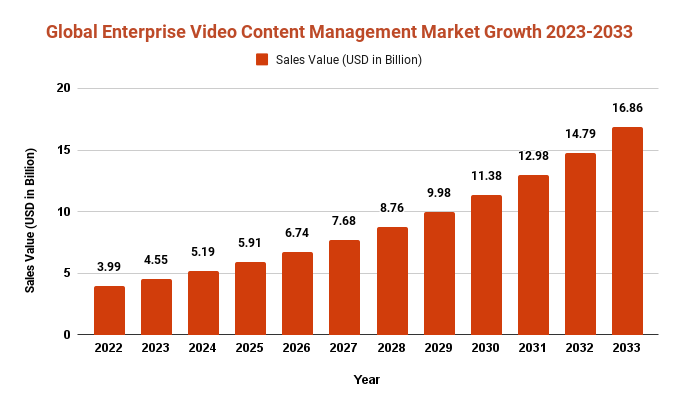Enterprise Video Content Management Market will anticipate around USD 16.86 Bn by 2033

Page Contents
Market Overview
Published Via 11Press: Enterprise video content management Market refers to the processes and technologies used for creating, managing, storing, distributing, and analyzing video content within an organization. It's essential for businesses that want to utilize video as a communication and marketing medium – whether for training purposes, webinars, live streaming events, product demos or other types of videos.
The Global Enterprise Video Content Management market represented USD 3.99 Bn in 2022 and will anticipate around USD 16.86 Bn by 2033 projected around CAGR of 14% amid forecast frame of 2023 to 2033.
An enterprise video content management system usually consists of several components, such as a video capture device, video management platform, content delivery network and analytics tools. The capture device records video content, while the management platform stores and organizes it. The content delivery network is utilized to distribute content to users, while analytics tools offer insight into how that content is being consumed and engaged with. Some of the advantages of an enterprise video content management system include increased engagement with customers and employees, better training and education, enhanced communication and collaboration, as well as greater brand awareness. Furthermore, an enterprise video content management system helps organizations streamline their workflows and reduce costs associated with traditional forms of communication and marketing.
Key Takeaways
- Enterprise video content management systems offer businesses the capabilities to create, edit, store, distribute and analyze video content.
- Video content can be utilized for a variety of purposes, such as training, webinars, live streaming events, product demos and marketing.
- Enterprise video content management systems typically consist of components such as a video capture device, management platform, content delivery network and analytics tools.
- Enterprise video content management systems offer numerous advantages, such as increased engagement with customers and employees, better training and education programs, enhanced communication and collaboration tools, and increased brand awareness.
- By harnessing the power of video, organizations can simplify their processes and reduce expenses associated with traditional forms of communication and marketing.

Get Enterprise Video Content Management Sample Report: https://marketresearch.biz/report/enterprise-video-content-management-market/request-sample/
Regional Snapshot
- North America: North America is the leading market for enterprise video content management, with a high demand for cloud-based video solutions. Many large enterprises in this region utilize video content management systems both internally for training and communication as well as external marketing and customer engagement activities.
- Europe: The enterprise video content management market in Europe is expanding steadily, driven by an increase in video adoption for corporate communications and training purposes. There's also a strong focus on compliance and data protection within this region, leading to the development of compliant video content management solutions that meet GDPR regulations.
- Asia-Pacific: The Asia-Pacific region is forecast to experience significant growth in the enterprise video content management market, due to an increasing adoption of video for e-learning and employee training. There are a large number of small and medium-sized enterprises (SMEs) in this region that are increasingly using video content to engage customers and market their products and services.
- Middle East and Africa: The enterprise video content management market in the Middle East and Africa is still developing, but it is expected to expand rapidly over the coming years. There is an increasing need for video content management solutions that are tailored to support regional language and cultural requirements.
Inquire with our industry specialist: https://marketresearch.biz/report/enterprise-video-content-management-market/#inquiry
Drivers
- Increasing demand for video-based communication and marketing: Video is becoming a preferred format for communication and marketing, as it can be more engaging and effective in delivering messages than text or static images.
- Growing need for remote collaboration and training: Remote work and online training have become increasingly prevalent, and video content management systems are an effective way to facilitate collaboration and training among remote teams.
- Advancements in technology: Advances in video technology have made it easier and more affordable for businesses to produce and distribute high-quality video content. Additionally, cloud-based video content management solutions have made it easier for businesses to manage their video content across multiple locations and devices.
- Increasing use of video for customer engagement: Video content is becoming an increasingly important tool for engaging with customers and building brand awareness. This has led to the development of video content management systems that are specifically designed for marketing and customer engagement.
- Need for data-driven insights: Video content management systems are often equipped with analytics tools that provide valuable insights into how videos are being consumed and engaged with. This helps businesses to optimize their video content and measure its impact on business outcomes.
Restraints
- Implementing a video content management system can be expensive, particularly for small and medium-sized businesses. This makes it difficult for these firms to justify investing in such an expensive system. Furthermore, video streaming and distribution require internet connectivity – something which may present problems if access is limited. Furthermore, since these systems contain sensitive or confidential information that could be vulnerable to cyber attacks or data breaches, businesses may hesitate to adopt these systems.
- Integration of a video content management system with existing enterprise software and systems can be an intricate and time-consuming endeavor, particularly for businesses that have already invested heavily in their existing technology infrastructure. Furthermore, the implementation and administration of such a system necessitate technical proficiency which may not be available within an organization – making it challenging for businesses to fully reap the rewards associated with having such a system in place.
Opportunities
- AI and machine learning can be utilized to extend the capabilities of video content management systems, such as automatic transcription, video tagging, and personalization. While these systems have traditionally been employed in industries like media , education, and healthcare; there is potential for them to be employed in new sectors like manufacturing , retailing, and finance. With increasing use of virtual and augmented reality in business settings; video content management systems are well suited for managing and distributing this content.
- Video analytics , such as facial recognition and emotion detection, are becoming more widely used. Video content management systems can be utilized to manage and analyse this data in order to provide valuable insights. Personalized video content tends to be more engaging and efficient in conveying messages than generic material does. Hence, these systems offer the capability of managing and distributing personalized video content.
Challenges
- Integrating video content management systems with existing enterprise software and systems can be a complex and time-consuming endeavor. Businesses that have already invested heavily in their existing technology infrastructure may face a challenge. User-generated content, such as videos created by employees or customers, may vary in quality and require extensive editing or filtering before being distributed. Video content management systems must adhere to various regulatory and legal requirements, such as data privacy laws. Ensuring compliance can be especially challenging in industries like healthcare and finance.
- Video content management systems often include analytics tools, but these may not provide the level of detail or granularity some businesses require. This makes it challenging to measure video content effectiveness and make data-driven decisions. Furthermore, the video content management market is rapidly advancing with new technologies and trends emerging on a regular basis; keeping up with these modifications and adapting to them can prove a daunting challenge for businesses and vendors alike.
Market Segmentation
On the basis of component type
- software platform
- support service
Based on industry
- media and entertainment
- healthcare
- retail and consumer goods
- banking
- financial services and insurance BFSI
- government IT and telecommunication
Application-wise
- training and development
- corporate communication
Key Players
- Microsoft Corp.
- IBM Corporation
- Kaltura Inc.
- Adobe Systems, Inc.
- Qumu, Inc.
- Panopto Inc.
- Brightcove, Inc.
- Sonic Foundry, Inc.
- MediaPlatform Inc.
- VBrick Systems Inc.
Report Scope
| Report Attribute | Details |
| Market size value in 2022 | USD 3.99 Bn |
| Revenue forecast by 2033 | USD 16.86 Bn |
| Growth Rate | CAGR Of 14% |
| Regions Covered | North America, Europe, Asia Pacific, Latin America, and Middle East & Africa, and Rest of the World |
| Historical Years | 2017-2022 |
| Base Year | 2022 |
| Estimated Year | 2023 |
| Short-Term Projection Year | 2028 |
| Long-Term Projected Year | 2033 |
Growing Demand => Request for Customization
Recent Developments
Here are some recent updates in the enterprise video content management market:
- Integration with Collaboration Tools: Video content management systems are increasingly being integrated with collaboration tools like Slack, Microsoft Teams and Zoom to allow users to easily share and collaborate on video content.
- Adoption of cloud-based solutions: Cloud-based video content management solutions are becoming more and more popular due to their scalability, versatility, and user friendliness. This trend is likely to continue as businesses look for ways to cut IT infrastructure expenses.
- Increased Utilization of AI and Machine Learning: AI and machine learning are being employed to extend video content management system capabilities, such as automatic transcription, video tagging , and personalization.
- Rise of Interactive Video: Interactive video, which allows viewers to engage with video content in real time, is becoming increasingly popular in business settings. Video content management systems are being utilized for managing and distributing this type of content.
- Expansion into New Industries: Video content management systems are being adopted in a variety of industries, such as manufacturing and retail, as businesses search for ways to use video content to streamline operations and engage customers more effectively.
Key Questions
Q: What is enterprise video content management?
A: Enterprise video content management is the process of organizing, managing and distributing video content within an organization. This includes activities such as video capture, editing, storage and delivery.
Q: What are some of the advantages of using a video content management system?
A: Video content management systems offer several advantages, such as improved collaboration, increased productivity, better training and onboarding processes, increased customer engagement levels and greater brand awareness.
Q: What are some key features of a video content management system?
A: Video content management systems typically come equipped with tools for video capture and editing, storage/archiving capabilities, distribution/delivery options, analytics/reporting tools, security/compliance checks and more.
Q: How can businesses guarantee the quality of user-generated video content?
A: Businesses can ensure user-generated video content meets quality expectations by offering guidelines and training for video creation, using editing and filtering tools to enhance it, as well as incorporating user feedback into the process.
Q: How can businesses guarantee compliance with regulatory and legal obligations when using video content management systems?
Businesses can guarantee compliance with regulatory and legal obligations by selecting a video content management system that offers robust security features, such as encryption, access controls, and audit trails. They should also guarantee that all video content is reviewed by legal and compliance teams before distribution.
Q: What are some current trends in the enterprise video content management market?
A: Some notable developments include cloud-based solutions, integration with collaboration tools, increased use of AI and ML technologies, expansion into new industries, as well as an uptick in interactive video production.
Contact us
Contact Person: Mr. Lawrence John
Marketresearch.Biz (Powered By Prudour Pvt. Ltd.)
Tel: +1 (347) 796-4335
Send Email: [email protected]
The team behind market.us, marketresearch.biz, market.biz and more. Our purpose is to keep our customers ahead of the game with regard to the markets. They may fluctuate up or down, but we will help you to stay ahead of the curve in these market fluctuations. Our consistent growth and ability to deliver in-depth analyses and market insight has engaged genuine market players. They have faith in us to offer the data and information they require to make balanced and decisive marketing decisions.